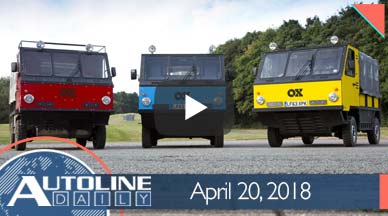
Runtime: 7:55
0:32 Low-Cost All-Terrain Vehicle
1:18 Shell & Toyota Move Forward with Hydrogen Project
1:50 Lyft To Offset Emissions
2:42 Osram Creates Infrared LEDs For Night Vision
3:27 This Weekend’s Races
4:35 State of Automaker/Supplier Relationship
Visit our sponsors to thank them for their support of Autoline Daily: Bridgestone , Dow Automotive Systems and Lear Corporation.
On today’s show…Shell and Gordon Murray Design are helping to bring low-cost transportation to developing countries…Osram creates new infrared LEDs for night vision…and a look at the state of the relationship between automakers and suppliers. All that and more coming right up on Autoline Daily.
This is Autoline Daily the show for enthusiasts of the automotive industry.
LOW-COST ALL-TERRAIN VEHICLE
Two years ago, Gordon Murray Design, the British design house, along with the Global Vehicle Trust, introduced a low-cost, all-terrain vehicle called the OX. It was created for poor, rural areas in developing countries. It can carry a payload of 1,900 kilograms or about 4,190 pounds and can seat up to 13 people. It can be self-assembled and it uses fewer and more accessible parts to keep maintenance costs low. And now the oil company Shell, has commissioned a pre-production prototype of the OX, to bring it to India by the end of the year. It will test the vehicle with its fluids, including Shell Rimula, a diesel oil used to make engines run more efficiently in all-terrain conditions.
SHELL & TOYOTA MOVE FORWARD WITH HYDROGEN PROJECT
And in other Shell news, the company is working with Toyota to develop a hydrogen refueling station for semi-trucks transporting cargo at the Port of Long Beach. And now the two companies have been provisionally awarded $8 million by the California Energy Commission to build the station. If approved, Shell will build, own and operate the station and will source the hydrogen from Toyota’s adjacent Tri-Gen facility, which produces hydrogen from 100 percent renewable bio-gas.
LYFT TO OFFSET EMISSIONS
And in other “Green” news, ride-hailing company Lyft is launching a program to offset emissions created by its cars. Reuters reports that the company will balance every mile driven, by buying carbon “offsets” to fund projects that support renewable energy and reforestation. Lyft did not reveal how much it expects to spend but it did share that its rides accounted for well over a billion miles driven in 2017.
And we’ll be back with more autonomous and racing news right after this.
OSRAM CREATES INFRARED LEDs FOR NIGHT VISION
Accidents involving autonomous vehicles where the AV is at fault, highlights the fact that this technology still needs improvement. Now lighting supplier Osram is coming out with a new range of enhanced infrared LEDs that will help in a number of applications. One set is intended for exterior driver assist and autonomous systems and will help with night vision, pedestrian protection and lane detection. The other set is suited for interior applications like driver and cabin monitoring and gesture recognition. And for each application there’s a number of wavelengths and beam angles to choose from. These new units expand Osram’s family of Olsen Black infrared LEDs.
START YOUR ENGINES…
Most racing series and networks don’t do a good job of promoting when races are on. In fact, we recently had a viewer write in to say they had missed last week’s Indy and NASCAR races for that very reason. So, we’ve decided to let you know what’s coming up this weekend. In NASCAR, the Toyota Owners 400 runs on Saturday at 6:30PM ET on Fox. Next up is NHRA Spring Nationals on Sunday at 2PM ET on Fox Sports. And Indy Car also runs on Sunday, but an hour later at 3PM ET on NBC Sports. Now you know when to have your favorite seat in front of the TV ready and a cold bee-beverage in your hand.
Coming up next, a look at the state of the relationship between automakers and suppliers.
STATE OF AUTOMAKER/SUPPLIER RELATIONSHIP
There’s always going to be tension between car companies and suppliers. Automakers want to pay suppliers as little as they can for their technology and components, while suppliers want to get as much money from carmakers as they can. On Autoline This Week, we’re joined by Julie Fream, the President and CEO of the Original Equipment Suppliers Association, and she talked about the current state of the OEM/Supplier relationship.
(The ATW preview is only available in the video version of today’s show.)
For more about the state of the supplier industry, you can watch that entire discussion right now on our website, Autoline.tv or on our YouTube channel.
But that’s it for today, thanks for watching and we’ll be right back here again on Monday.
Thanks to our partner for embedding Autoline Daily on its website: WardsAuto.com

John McElroy is an influential thought leader in the automotive industry. He is a journalist, lecturer, commentator and entrepreneur. He created “Autoline Daily,” the first industry webcast of industry news and analysis.




